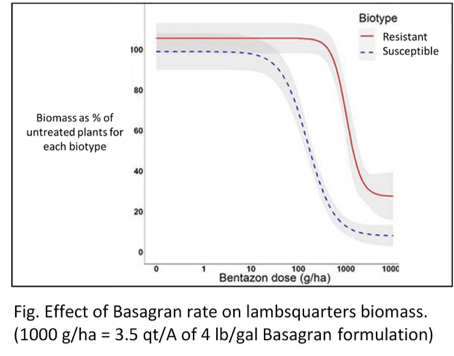Raptor herbicide (imazamox, Group 2) was labeled by BASF for use on snap beans in the Willamette Valley of western Oregon in 2002. Imazamox is an ALS inhibitor, and herbicide resistance commonly develops quickly with this class of herbicides. Yet there is no evidence that any weed populations have become resistant to this class of herbicides in western Oregon. The main targets of this herbicide in snap beans are black and hairy nightshade. Despite an application to more than 50% of the snap bean acreage each year (roughly 6 to 10,000 acres), there is no evidence that the herbicide is less effective now than when it was first labeled.
But the story does not end there. Basagran (bentazon, Group 6, PSII inhibitor) is a required tankmix with Raptor because it improves crop safety when Raptor is applied to snap beans. Depending on species present, Basagran (5l) is applied at a range of 6 oz/A (if pigweed is the dominant weed) to 16 oz/A (if lambsquarters dominates). In 2018, 16 years after the Raptor and Basagran tankmix was first used, a representative of a local agribusiness found some lambsquarters seedlings that survived a direct hit and a typically lethal dose of Basagran. Consequent grow out and analysis found that indeed, progeny from the surviving plants were moderately resistant to Basagran (Fig). Rumors have been circulating that lambsquarters is getting harder to kill with Basagran.
What could be the cause of this unexpected outcome? Why did nightshade not become resistant to Raptor as was expected? First, the only other use for Raptor in western Oregon is clover grown for seed. Additionally, there are no other ALS herbicides labeled in snap beans or other row crops that have any efficacy on the nightshades, and therefore selection pressure for resistance to ALS inhibitors in this cropping system is low, despite heavy use in snap beans. Snap beans also are rotated with many other crops and seldom grown in any one field more than once every 3 years because of disease pressure. These factors have probably kept herbicide resistance at bay in the nightshades. It should be noted, however, that resistance to ALS herbicides in the nightshade family has been observed in other parts of the country and world in cropping systems where selection pressure from this herbicide group is considerably stronger (e.g. soybeans).
Basagran on the other hand is used in several crops including beans, peas, corn and sorghum, and mint and is very effective on lambsquarters. Lambsquarters is also found in western Oregon that is very tolerant of other PSII inhibitors like atrazine. In snap beans, the tank-mix maximum rate of Basagran is only 1 pt/A, lower than the optimum rate to kill large lambsquarters. The rate of Basagran is kept low to prevent too much ‘safening’ on moderately susceptible grasses and pigweed. Perhaps the wider use of Basagran, the lower rate when tank-mixed with Raptor and cross-resistance with other PSII inhibitors has presented a window of opportunity for lambsquarters.
Other than the demonstration of Basagran resistance in lambsquarters, the causes of this outcome are merely speculation and eventually may be sorted. But until then, this is a good reminder that weeds often find a way to win despite our best predictions
